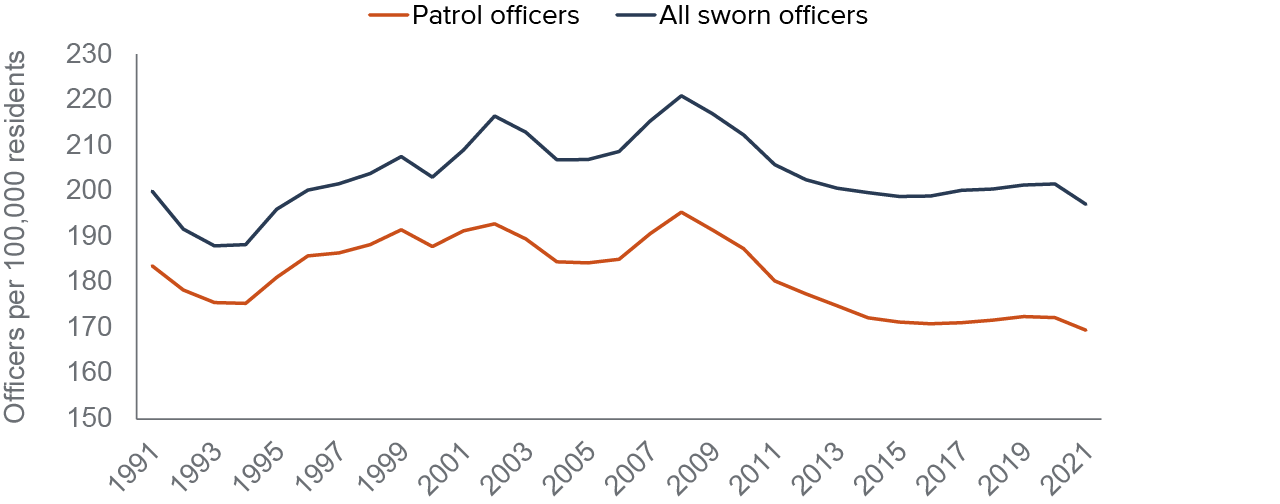Law enforcement funding mainly comes from local sources.
- California cities spent more than $14.4 billion on policing in the 2020–21 fiscal year, while counties spent $7.8 billion and the state spent $2.7 billion on the California Highway Patrol (CHP).
- Police funding is typically the largest spending area for cities, accounting for over 15% of all city spending statewide; fire services are the next largest category of spending (6.5%). However, there is substantial variation across communities.
- City and county police protection is funded by property, business, and sales taxes; federal and state grants; local fees and fines; and voter-approved general and special sales taxes.
Almost half of California’s law enforcement officers work for municipal police departments.
- In 2021, there were close to 117,600 full-time law enforcement employees in California; roughly 77,600 were sworn law enforcement officers (with full arrest powers) and about 40,000 were civilian staff.
- Of all sworn officers, about 48% were municipal police officers, while 39% were county sheriff deputies and 9% worked for the CHP. About 4% were employed by other agencies, such as university, port, and transportation districts and the State Department of Parks and Recreation.
Staffing levels dropped significantly in 2021.
- Between 2020 and 2021, the state lost 2,100 sworn staff and about 1,100 civilian staff—declines of 2.6% and 2.8%, respectively.
- The number of patrol officers per 100,000 residents is the lowest since at least 1991, while the total number of sworn officers per 100,000 residents is now at the lowest level since 1995.
- Of the 458 agencies that reported staffing numbers in both 2020 and 2021, 213 (46.5%) reported fewer sworn officers, 96 (21%) reported no change, and 149 (32.5%) reported more officers in 2021 than 2020.
- In 2018, California had fewer officers per 100,000 residents than the nation overall—but more than two neighboring states, Oregon and Arizona.
The number of patrol officers per 100,000 residents has declined to 1991 levels

SOURCE: Authors’ calculation based on California Department of Justice’s Law Enforcement Personnel Survey and California Department of Finance Population Data, 1991–2021.
NOTES: The category of patrol officers includes all sworn law enforcement personnel who are not reported as jail employees. A majority of these officers are patrolling highways and neighborhoods, but the category does also include police chiefs, supervisors, and detectives.
Sworn law enforcement staff predominantly work as patrol officers, and most are male.
- Of the roughly 77,600 sworn officers in 2021, about 66,720 were patrol officers and over 10,870 worked in county jails.
- In 2021, there were roughly 29,720 civilian staff in municipal police departments, CHP, and other non-jail settings, and 10,240 civilian staff in jails.
- Of all sworn officers, 66,785 (or 86%) were male. Of the roughly 41,600 civilian staff, only 15,055 (or 38%) were male.
Views of local law enforcement’s ability to control crime has recently declined.
- According to the February 2023 PPIC Statewide Survey, 46% of Californians think the police in their community do an excellent or good job in controlling crime. During a period where the state, and the nation, has seen troubling increases in homicides and aggravated assaults, this view of police has notably decreased by 16 percentage points from February 2020.
- Only 31% of Black Californians think the police in their communities do an excellent or good job in controlling crime, compared to 45% of Asian Americans, 46% of Latinos, and 49% of white Californians.
- Furthermore, according to the February 2022 PPIC Statewide Survey, only 37% of Black Californians say police treat all racial and ethnic groups fairly most of the time or almost always, compared to majorities of Asian American (56%), Latino (52%), and white (62%) Californians.
Identifying equitable, cost-effective ways to prevent crime is vital.
- Recent research finds that increased police staffing can help prevent crime: each additional officer reduces crime by 1.3 violent crimes and 4.2 property crimes per year, primarily through deterrence. Research also estimates that the crime-reducing benefits of hiring an additional police officer exceed the annual cost.
- While the research finds that increased staffing results in a greater reduction in homicides of Black victims than white victims, it also finds increases in arrests for lower-level offenses like liquor violations and disorderly conducts that fall disproportionately on Black residents.
- Concerns about police practices and staffing could prompt communities to explore other programs and strategies that may also prove cost-effective. Possible approaches include preventive interventions among at-risk youth, people with behavioral and substance use challenges, and other targeted groups.
In 2018, California had fewer officers per 100,000 residents than the US overall—but more than Oregon and Arizona

SOURCE: Bureau of Justice Statistics, Census of State and Local Law Enforcement Agencies, 2018.
NOTES: 2018 is currently the most recent year available. The rate for the District of Columbia is not included in this figure (and is not factored into the US-wide rate of officers per 100,000 residents).



